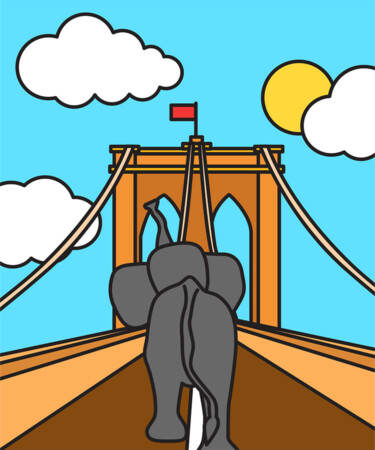This article is part of our Cocktail Chatter series, where we dive into the wild, weird, and wondrous corners of history to share over a cocktail and impress your friends.
With hundreds of thousands of pedestrians, bikers, and vehicles crossing over the iconic Brooklyn Bridge every day, it’s hard to imagine New Yorkers not putting their trust in the engineers who built the architectural marvel. But when the bridge was first opened to the public on May 30, 1883, the city’s residents approached the bridge with a degree of skepticism that led to full-on hysteria. And the only thing that could assuage their fears came from an unlikely place: the circus.
When the Brooklyn Bridge was constructed, it was not only the first bridge to span the length of New York’s East River, but it was the longest suspension bridge in the world — measuring nearly 1,600 feet, approximately 800 feet longer than any previously constructed. At such lengths, many anxious city-goers expressed concerns that the bridge would not be structurally sound enough to support the sheer number of people expected to utilize it. The public’s hesitance was so prominent that the world’s now most famous ringmaster, Ringling Bros. and Barnum & Bailey circus founder Phineas Taylor Barnum — better known as P.T. Barnum — offered the city $5,000 to allow him to cross the bridge with his many and massive circus animals to prove its security.
The city turned down his offer, which proved to be a tragic mistake. Just one week after the bridge opened, a crowd surge and subsequent stampede would turn deadly. According to reports at the time, a woman tripped while ascending the steps of the bridge, causing another to scream, which was enough for the remainder of the individuals on the bridge to think the structure was crumbling. The crowd surged rapidly, killing 12 people, seriously injuring seven, and leaving 28 more with minor injuries.
And so, one year after the Brooklyn Bridge’s opening, New York City officials took P.T. Barnum up on his offer to put together a demonstration to show off the bridge’s inherent strength. On May 17, 1884, the world’s greatest showman herded up 21 elephants and 17 camels from his circus and marched them across the bridge from Brooklyn to Manhattan. Included in the procession was Barnum’s distinctive white elephant, Toung Taloung, and his most famous and most beloved elephant, Jumbo, who brought up the caboose.
According to The New York Times’s reporting at the time, crowds of people flocked to the bridge to “catch a glimpse of the spectacle.” That day, crossing fares were voided for all, as “the question of how much an elephant or a dromedary should pay stumped the Superintendent [of Tolls].” The Times said that the elephants shuffled along in the precession, “raising their trumps and snorting as every train went by,” and from the onlookers viewpoint, “it seemed as if Noah’s Ark were emptying itself over on Long Island.”
The animals weighed a cumulative total of 10,000 pounds. And with them, P.T. Barnum and the City of New York accomplished their goal of demonstrating the bridge’s ability to safely support the weight of commuting New Yorkers. Today, the Brooklyn Bridge lives on as one of the city’s — and the world’s — most iconic landmarks.
